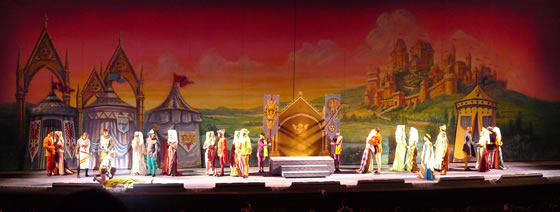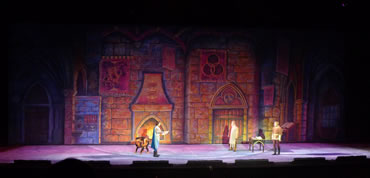 |  |  | |
News & Notices
News From:
Commissions
Portfolio Reviews
Conference & Stage Expo
For the Record
 | ||
| Session to Focus on 'MUNY Magic' Fifty years ago, the theatre industry looked quite different than it does today. If anyone would have suggested that lighting fixtures could move, change color, pattern, and shape all with a blink of an eye and not require the assistance of two or three stage hands, no one would have believed them. Today people have become accustomed to technological advances that make the lives of designers easier, while making technical rehearsals much longer and more painful! There is one place that still embraces many of the “old school” traditions of the theatre – the St. Louis MUNY Theatre. This American, iconic, outdoor theatre, incorporated in 1919, opened its first season with Robin Hood and has since gone on to present America’s most beloved musicals to literally millions of patrons. Heading into its 92nd season, the 2010 summer will feature the musical Beauty and the Beast along with six additional productions between mid June and the first week of August. Admiring audiences will come out to see their favorite St. Louis and New York performers as well as designs that feature works by Tony Award-nominated lighting designers and prolific regional theatre and Broadway set designers. But what truly sets this theatre apart from all others is the paint staff. The scenics at the MUNY have the incredibly challenging task of taking traditional Broadway style muslin covered flats and turn them into works of art that resonate with patrons in the box seats 25 feet away, to the 2,000 free seat section 350 feet from the stage. In an era of “digital” scenery, this staff works in the traditional methods of scenic art that have been taught since the turn of the 20th century. The only advancements that have been made in the areas of premixed paints as opposed to dry pigment and hide glue, but the techniques remain the same. The MUNY painters have the formidable task of turning highly detailed painter’s elevations into gigantic scenic units in just under 11 days. In addition to the short time frame, the painters have only one night of technical rehearsal where most, not all, of the scenery is on stage. During this midnight to 6 a.m. technical rehearsal, all paint notes are taken by the design staff and presented to the painters the following morning where they will have just under five hours to complete pages and pages of notes – which they usually do. One of the most incredible scenic units at the MUNY is the boom. The boom is a 23-by-84-foot show “curtain” that is used to close off the back stage from the audience in order to make scene changes. This unique piece of scenery is truly a work of art as it is painted by three Union scenic artists in just over three days and is never seen under stage light until opening night.
In order to pay tribute to this wonderfully iconic “factory” of a theatre, a session will be presented at the Kansas City 2010 Conference & Stage Expo to explore how the scenery is constructed, painted, and mounted in just under 11 days. The session, from 5 to 6:15 p.m. on Thursday, April 1, will feature a short documentary film that will include interviews with the scenic artists who are responsible for making the “MUNY Magic” happen along with video clips of the paint process. A look at the unique tools that have been developed over the years to accommodate the “MUNY scale” will be featured in this film as well as the myriad of other factors that go into creating theatre of this scale. At the conclusion of the film, designers Steve Gilliam and Michael Riha will take questions and lead a discussion of the art and challenges of painting for large outdoor theatres. | See how the St. Louis MUNY Theatre creates stunning stage presentations for outdoor drams during a special session at USITT's 50th Annual Conference in Kansas City, Missouri. Photos/ Michael J. Riha | |
United States Institute for Theatre Technology, Inc.: © 2010 Volume L, Number 2
